Human Resource Management Report: Merrill Lynch Case Study Analysis
VerifiedAdded on 2021/02/19
|15
|4625
|56
Report
AI Summary
This report provides a comprehensive overview of Human Resource Management (HRM) practices, specifically focusing on the application of these practices within Merrill Lynch. The report begins by defining HRM and its core functions, including recruitment, selection, training, and development. It then delves into the strengths and weaknesses of various recruitment and selection approaches, such as internal and external recruitment methods, as well as different selection processes like interviews and assessment tests. The report further explores the benefits of effective HRM practices, including the use of performance management systems to improve employee engagement and productivity. Additionally, it examines the importance of employee relations and the impact of employment legislation on HRM decision-making. Finally, the report concludes by highlighting the practical application of HRM practices in a work-related context, emphasizing the significance of these practices in achieving organizational goals and fostering a positive work environment at Merrill Lynch.
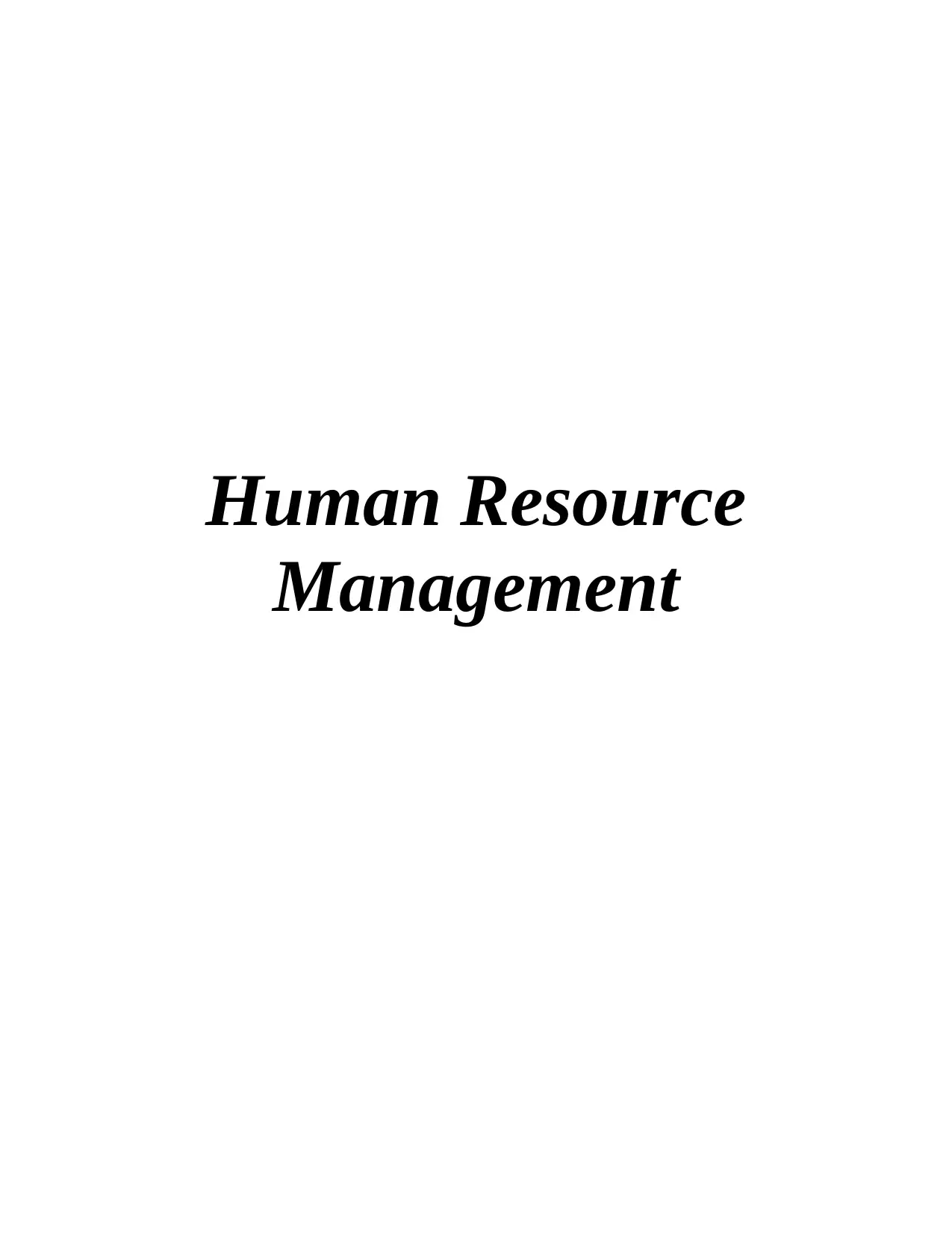
Human Resource
Management
Management
Paraphrase This Document
Need a fresh take? Get an instant paraphrase of this document with our AI Paraphraser
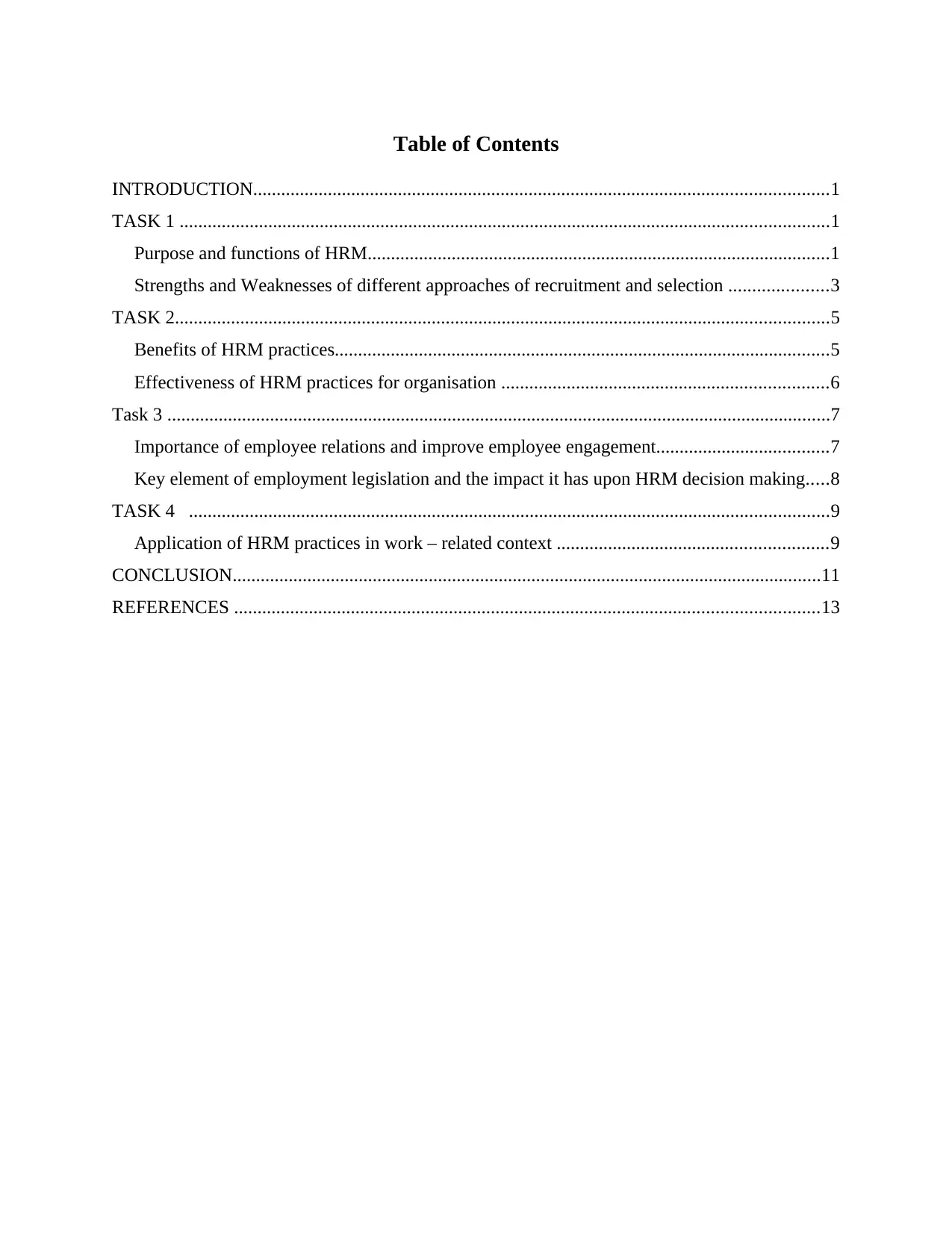
Table of Contents
INTRODUCTION...........................................................................................................................1
TASK 1 ...........................................................................................................................................1
Purpose and functions of HRM...................................................................................................1
Strengths and Weaknesses of different approaches of recruitment and selection .....................3
TASK 2............................................................................................................................................5
Benefits of HRM practices..........................................................................................................5
Effectiveness of HRM practices for organisation ......................................................................6
Task 3 ..............................................................................................................................................7
Importance of employee relations and improve employee engagement.....................................7
Key element of employment legislation and the impact it has upon HRM decision making.....8
TASK 4 .........................................................................................................................................9
Application of HRM practices in work – related context ..........................................................9
CONCLUSION..............................................................................................................................11
REFERENCES .............................................................................................................................13
INTRODUCTION...........................................................................................................................1
TASK 1 ...........................................................................................................................................1
Purpose and functions of HRM...................................................................................................1
Strengths and Weaknesses of different approaches of recruitment and selection .....................3
TASK 2............................................................................................................................................5
Benefits of HRM practices..........................................................................................................5
Effectiveness of HRM practices for organisation ......................................................................6
Task 3 ..............................................................................................................................................7
Importance of employee relations and improve employee engagement.....................................7
Key element of employment legislation and the impact it has upon HRM decision making.....8
TASK 4 .........................................................................................................................................9
Application of HRM practices in work – related context ..........................................................9
CONCLUSION..............................................................................................................................11
REFERENCES .............................................................................................................................13

⊘ This is a preview!⊘
Do you want full access?
Subscribe today to unlock all pages.

Trusted by 1+ million students worldwide
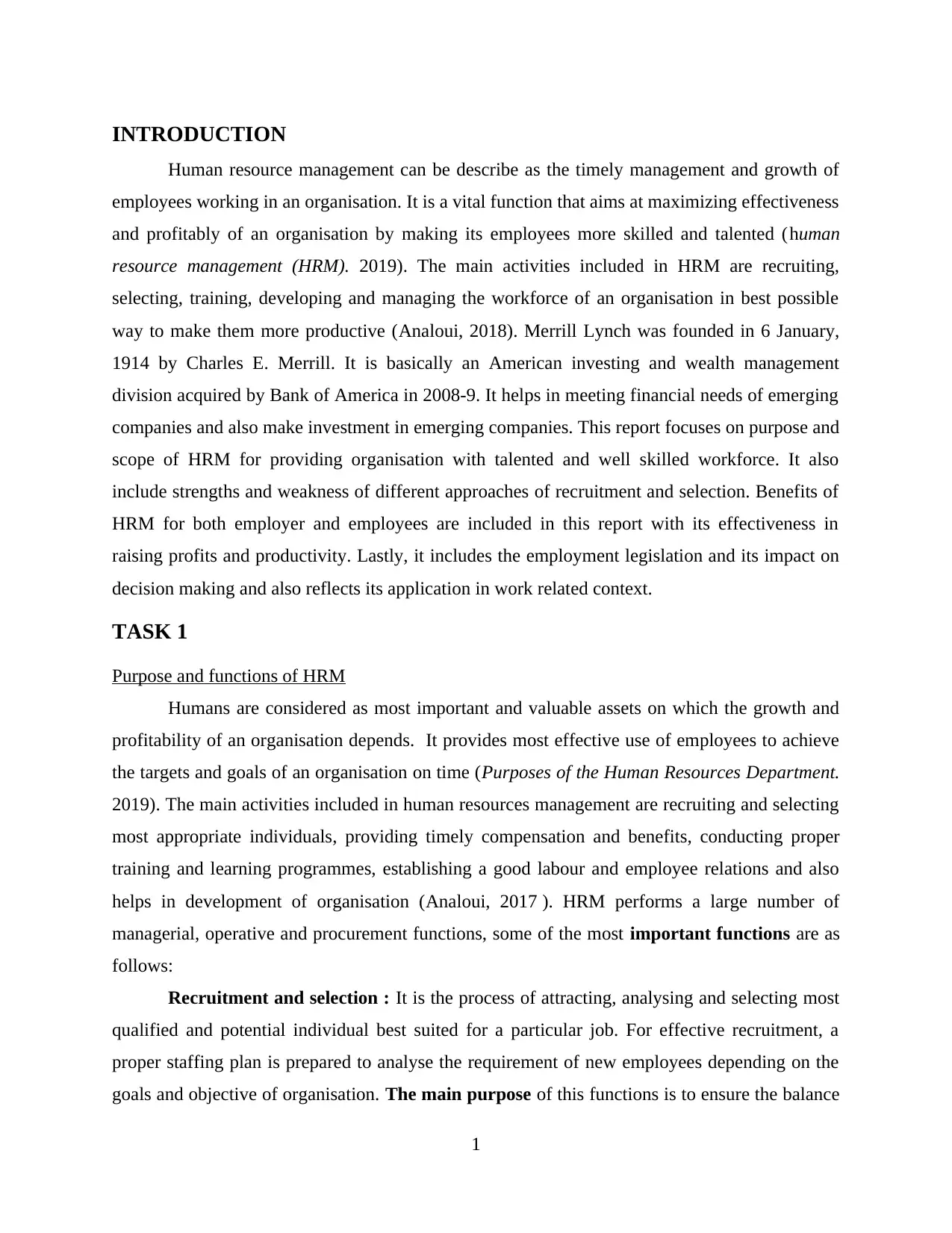
INTRODUCTION
Human resource management can be describe as the timely management and growth of
employees working in an organisation. It is a vital function that aims at maximizing effectiveness
and profitably of an organisation by making its employees more skilled and talented (human
resource management (HRM). 2019). The main activities included in HRM are recruiting,
selecting, training, developing and managing the workforce of an organisation in best possible
way to make them more productive (Analoui, 2018). Merrill Lynch was founded in 6 January,
1914 by Charles E. Merrill. It is basically an American investing and wealth management
division acquired by Bank of America in 2008-9. It helps in meeting financial needs of emerging
companies and also make investment in emerging companies. This report focuses on purpose and
scope of HRM for providing organisation with talented and well skilled workforce. It also
include strengths and weakness of different approaches of recruitment and selection. Benefits of
HRM for both employer and employees are included in this report with its effectiveness in
raising profits and productivity. Lastly, it includes the employment legislation and its impact on
decision making and also reflects its application in work related context.
TASK 1
Purpose and functions of HRM
Humans are considered as most important and valuable assets on which the growth and
profitability of an organisation depends. It provides most effective use of employees to achieve
the targets and goals of an organisation on time (Purposes of the Human Resources Department.
2019). The main activities included in human resources management are recruiting and selecting
most appropriate individuals, providing timely compensation and benefits, conducting proper
training and learning programmes, establishing a good labour and employee relations and also
helps in development of organisation (Analoui, 2017 ). HRM performs a large number of
managerial, operative and procurement functions, some of the most important functions are as
follows:
Recruitment and selection : It is the process of attracting, analysing and selecting most
qualified and potential individual best suited for a particular job. For effective recruitment, a
proper staffing plan is prepared to analyse the requirement of new employees depending on the
goals and objective of organisation. The main purpose of this functions is to ensure the balance
1
Human resource management can be describe as the timely management and growth of
employees working in an organisation. It is a vital function that aims at maximizing effectiveness
and profitably of an organisation by making its employees more skilled and talented (human
resource management (HRM). 2019). The main activities included in HRM are recruiting,
selecting, training, developing and managing the workforce of an organisation in best possible
way to make them more productive (Analoui, 2018). Merrill Lynch was founded in 6 January,
1914 by Charles E. Merrill. It is basically an American investing and wealth management
division acquired by Bank of America in 2008-9. It helps in meeting financial needs of emerging
companies and also make investment in emerging companies. This report focuses on purpose and
scope of HRM for providing organisation with talented and well skilled workforce. It also
include strengths and weakness of different approaches of recruitment and selection. Benefits of
HRM for both employer and employees are included in this report with its effectiveness in
raising profits and productivity. Lastly, it includes the employment legislation and its impact on
decision making and also reflects its application in work related context.
TASK 1
Purpose and functions of HRM
Humans are considered as most important and valuable assets on which the growth and
profitability of an organisation depends. It provides most effective use of employees to achieve
the targets and goals of an organisation on time (Purposes of the Human Resources Department.
2019). The main activities included in human resources management are recruiting and selecting
most appropriate individuals, providing timely compensation and benefits, conducting proper
training and learning programmes, establishing a good labour and employee relations and also
helps in development of organisation (Analoui, 2017 ). HRM performs a large number of
managerial, operative and procurement functions, some of the most important functions are as
follows:
Recruitment and selection : It is the process of attracting, analysing and selecting most
qualified and potential individual best suited for a particular job. For effective recruitment, a
proper staffing plan is prepared to analyse the requirement of new employees depending on the
goals and objective of organisation. The main purpose of this functions is to ensure the balance
1
Paraphrase This Document
Need a fresh take? Get an instant paraphrase of this document with our AI Paraphraser
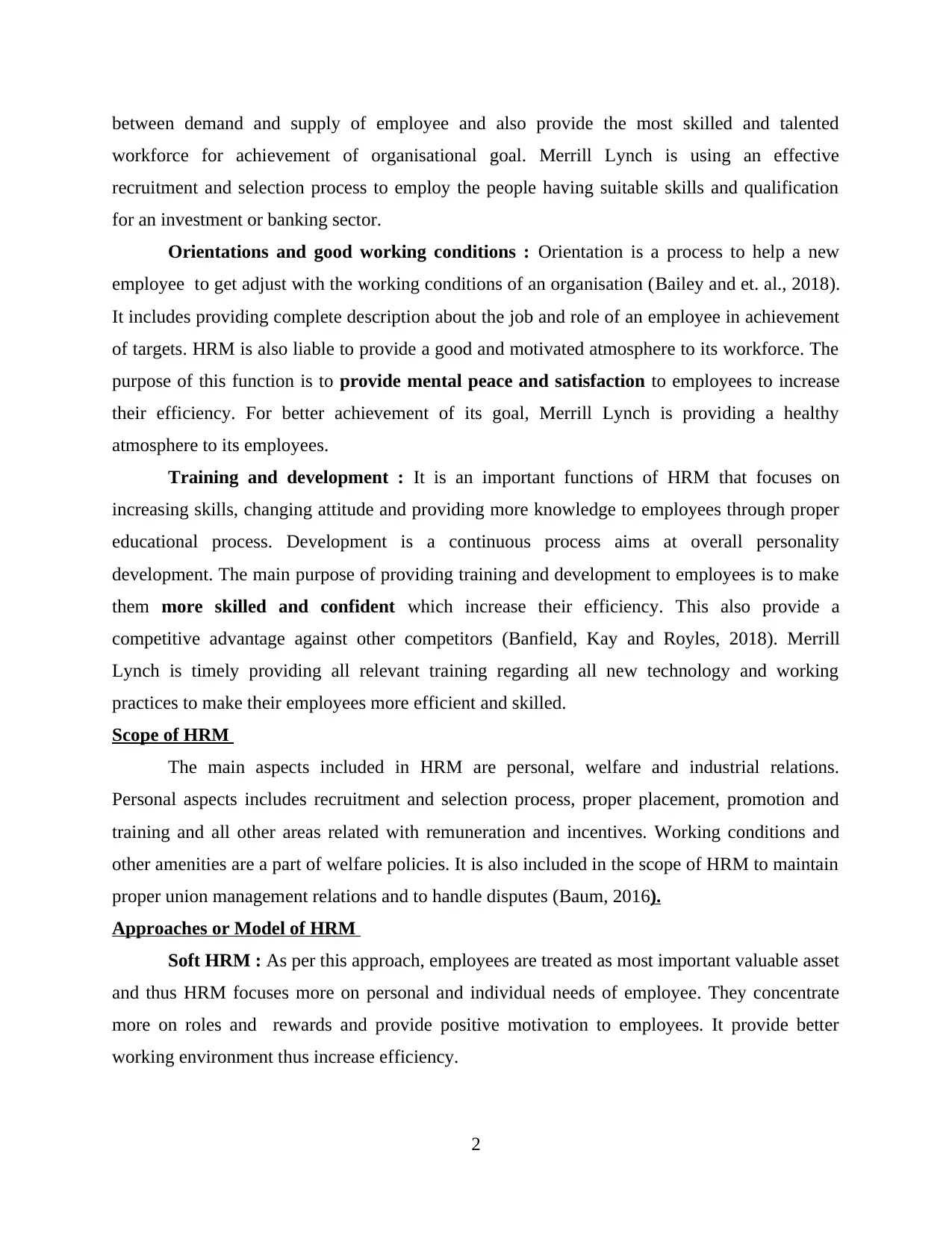
between demand and supply of employee and also provide the most skilled and talented
workforce for achievement of organisational goal. Merrill Lynch is using an effective
recruitment and selection process to employ the people having suitable skills and qualification
for an investment or banking sector.
Orientations and good working conditions : Orientation is a process to help a new
employee to get adjust with the working conditions of an organisation (Bailey and et. al., 2018).
It includes providing complete description about the job and role of an employee in achievement
of targets. HRM is also liable to provide a good and motivated atmosphere to its workforce. The
purpose of this function is to provide mental peace and satisfaction to employees to increase
their efficiency. For better achievement of its goal, Merrill Lynch is providing a healthy
atmosphere to its employees.
Training and development : It is an important functions of HRM that focuses on
increasing skills, changing attitude and providing more knowledge to employees through proper
educational process. Development is a continuous process aims at overall personality
development. The main purpose of providing training and development to employees is to make
them more skilled and confident which increase their efficiency. This also provide a
competitive advantage against other competitors (Banfield, Kay and Royles, 2018). Merrill
Lynch is timely providing all relevant training regarding all new technology and working
practices to make their employees more efficient and skilled.
Scope of HRM
The main aspects included in HRM are personal, welfare and industrial relations.
Personal aspects includes recruitment and selection process, proper placement, promotion and
training and all other areas related with remuneration and incentives. Working conditions and
other amenities are a part of welfare policies. It is also included in the scope of HRM to maintain
proper union management relations and to handle disputes (Baum, 2016).
Approaches or Model of HRM
Soft HRM : As per this approach, employees are treated as most important valuable asset
and thus HRM focuses more on personal and individual needs of employee. They concentrate
more on roles and rewards and provide positive motivation to employees. It provide better
working environment thus increase efficiency.
2
workforce for achievement of organisational goal. Merrill Lynch is using an effective
recruitment and selection process to employ the people having suitable skills and qualification
for an investment or banking sector.
Orientations and good working conditions : Orientation is a process to help a new
employee to get adjust with the working conditions of an organisation (Bailey and et. al., 2018).
It includes providing complete description about the job and role of an employee in achievement
of targets. HRM is also liable to provide a good and motivated atmosphere to its workforce. The
purpose of this function is to provide mental peace and satisfaction to employees to increase
their efficiency. For better achievement of its goal, Merrill Lynch is providing a healthy
atmosphere to its employees.
Training and development : It is an important functions of HRM that focuses on
increasing skills, changing attitude and providing more knowledge to employees through proper
educational process. Development is a continuous process aims at overall personality
development. The main purpose of providing training and development to employees is to make
them more skilled and confident which increase their efficiency. This also provide a
competitive advantage against other competitors (Banfield, Kay and Royles, 2018). Merrill
Lynch is timely providing all relevant training regarding all new technology and working
practices to make their employees more efficient and skilled.
Scope of HRM
The main aspects included in HRM are personal, welfare and industrial relations.
Personal aspects includes recruitment and selection process, proper placement, promotion and
training and all other areas related with remuneration and incentives. Working conditions and
other amenities are a part of welfare policies. It is also included in the scope of HRM to maintain
proper union management relations and to handle disputes (Baum, 2016).
Approaches or Model of HRM
Soft HRM : As per this approach, employees are treated as most important valuable asset
and thus HRM focuses more on personal and individual needs of employee. They concentrate
more on roles and rewards and provide positive motivation to employees. It provide better
working environment thus increase efficiency.
2
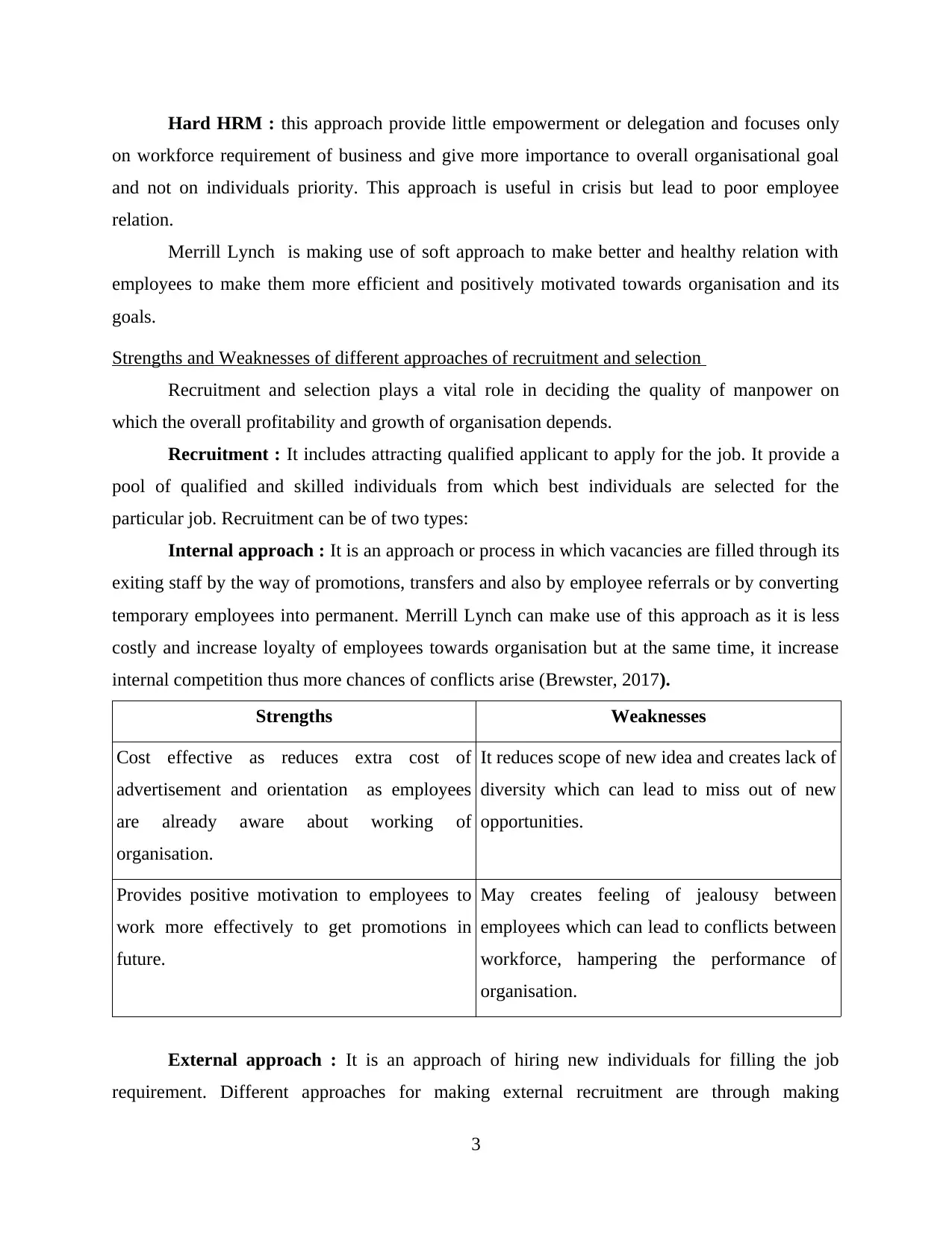
Hard HRM : this approach provide little empowerment or delegation and focuses only
on workforce requirement of business and give more importance to overall organisational goal
and not on individuals priority. This approach is useful in crisis but lead to poor employee
relation.
Merrill Lynch is making use of soft approach to make better and healthy relation with
employees to make them more efficient and positively motivated towards organisation and its
goals.
Strengths and Weaknesses of different approaches of recruitment and selection
Recruitment and selection plays a vital role in deciding the quality of manpower on
which the overall profitability and growth of organisation depends.
Recruitment : It includes attracting qualified applicant to apply for the job. It provide a
pool of qualified and skilled individuals from which best individuals are selected for the
particular job. Recruitment can be of two types:
Internal approach : It is an approach or process in which vacancies are filled through its
exiting staff by the way of promotions, transfers and also by employee referrals or by converting
temporary employees into permanent. Merrill Lynch can make use of this approach as it is less
costly and increase loyalty of employees towards organisation but at the same time, it increase
internal competition thus more chances of conflicts arise (Brewster, 2017).
Strengths Weaknesses
Cost effective as reduces extra cost of
advertisement and orientation as employees
are already aware about working of
organisation.
It reduces scope of new idea and creates lack of
diversity which can lead to miss out of new
opportunities.
Provides positive motivation to employees to
work more effectively to get promotions in
future.
May creates feeling of jealousy between
employees which can lead to conflicts between
workforce, hampering the performance of
organisation.
External approach : It is an approach of hiring new individuals for filling the job
requirement. Different approaches for making external recruitment are through making
3
on workforce requirement of business and give more importance to overall organisational goal
and not on individuals priority. This approach is useful in crisis but lead to poor employee
relation.
Merrill Lynch is making use of soft approach to make better and healthy relation with
employees to make them more efficient and positively motivated towards organisation and its
goals.
Strengths and Weaknesses of different approaches of recruitment and selection
Recruitment and selection plays a vital role in deciding the quality of manpower on
which the overall profitability and growth of organisation depends.
Recruitment : It includes attracting qualified applicant to apply for the job. It provide a
pool of qualified and skilled individuals from which best individuals are selected for the
particular job. Recruitment can be of two types:
Internal approach : It is an approach or process in which vacancies are filled through its
exiting staff by the way of promotions, transfers and also by employee referrals or by converting
temporary employees into permanent. Merrill Lynch can make use of this approach as it is less
costly and increase loyalty of employees towards organisation but at the same time, it increase
internal competition thus more chances of conflicts arise (Brewster, 2017).
Strengths Weaknesses
Cost effective as reduces extra cost of
advertisement and orientation as employees
are already aware about working of
organisation.
It reduces scope of new idea and creates lack of
diversity which can lead to miss out of new
opportunities.
Provides positive motivation to employees to
work more effectively to get promotions in
future.
May creates feeling of jealousy between
employees which can lead to conflicts between
workforce, hampering the performance of
organisation.
External approach : It is an approach of hiring new individuals for filling the job
requirement. Different approaches for making external recruitment are through making
3
⊘ This is a preview!⊘
Do you want full access?
Subscribe today to unlock all pages.

Trusted by 1+ million students worldwide
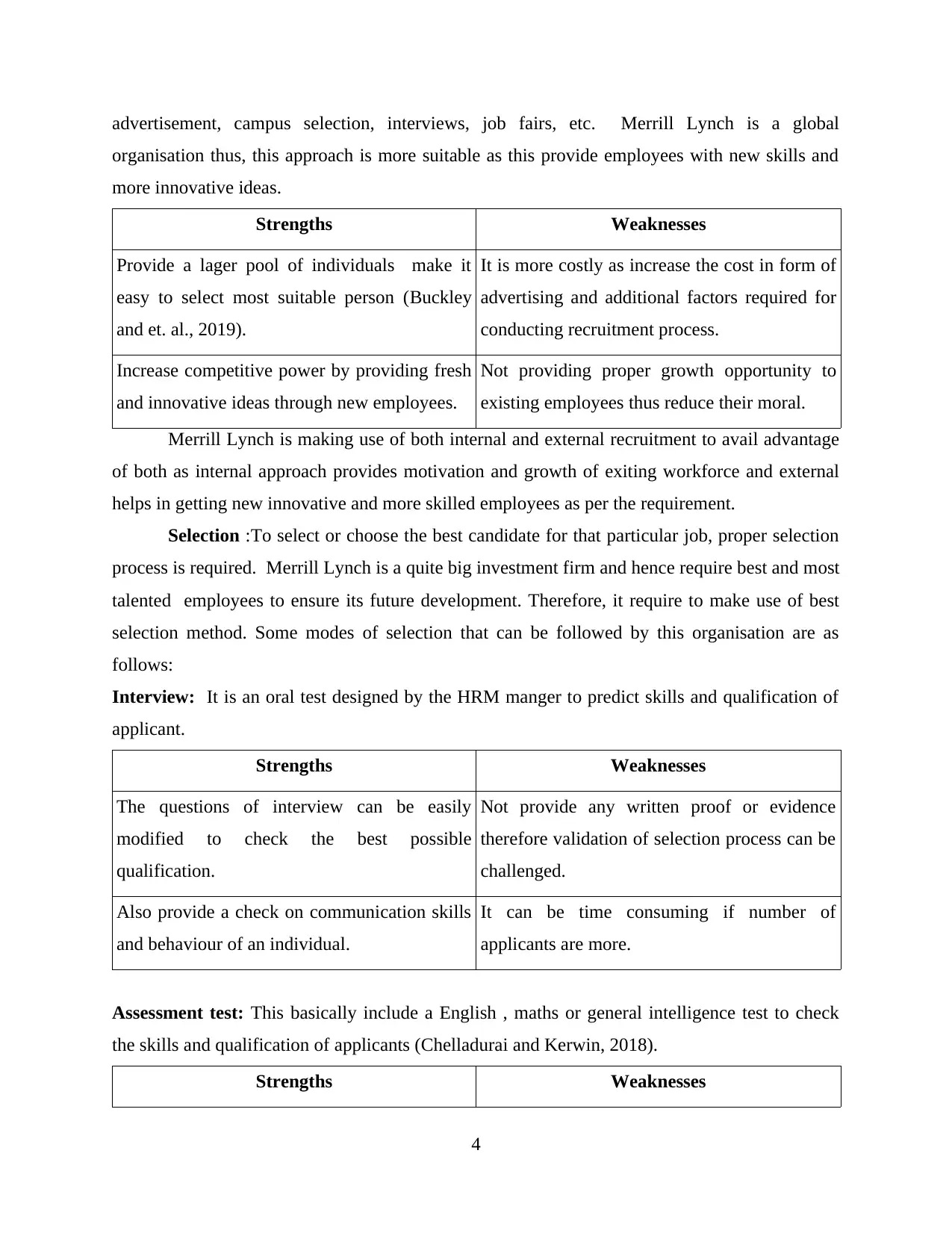
advertisement, campus selection, interviews, job fairs, etc. Merrill Lynch is a global
organisation thus, this approach is more suitable as this provide employees with new skills and
more innovative ideas.
Strengths Weaknesses
Provide a lager pool of individuals make it
easy to select most suitable person (Buckley
and et. al., 2019).
It is more costly as increase the cost in form of
advertising and additional factors required for
conducting recruitment process.
Increase competitive power by providing fresh
and innovative ideas through new employees.
Not providing proper growth opportunity to
existing employees thus reduce their moral.
Merrill Lynch is making use of both internal and external recruitment to avail advantage
of both as internal approach provides motivation and growth of exiting workforce and external
helps in getting new innovative and more skilled employees as per the requirement.
Selection :To select or choose the best candidate for that particular job, proper selection
process is required. Merrill Lynch is a quite big investment firm and hence require best and most
talented employees to ensure its future development. Therefore, it require to make use of best
selection method. Some modes of selection that can be followed by this organisation are as
follows:
Interview: It is an oral test designed by the HRM manger to predict skills and qualification of
applicant.
Strengths Weaknesses
The questions of interview can be easily
modified to check the best possible
qualification.
Not provide any written proof or evidence
therefore validation of selection process can be
challenged.
Also provide a check on communication skills
and behaviour of an individual.
It can be time consuming if number of
applicants are more.
Assessment test: This basically include a English , maths or general intelligence test to check
the skills and qualification of applicants (Chelladurai and Kerwin, 2018).
Strengths Weaknesses
4
organisation thus, this approach is more suitable as this provide employees with new skills and
more innovative ideas.
Strengths Weaknesses
Provide a lager pool of individuals make it
easy to select most suitable person (Buckley
and et. al., 2019).
It is more costly as increase the cost in form of
advertising and additional factors required for
conducting recruitment process.
Increase competitive power by providing fresh
and innovative ideas through new employees.
Not providing proper growth opportunity to
existing employees thus reduce their moral.
Merrill Lynch is making use of both internal and external recruitment to avail advantage
of both as internal approach provides motivation and growth of exiting workforce and external
helps in getting new innovative and more skilled employees as per the requirement.
Selection :To select or choose the best candidate for that particular job, proper selection
process is required. Merrill Lynch is a quite big investment firm and hence require best and most
talented employees to ensure its future development. Therefore, it require to make use of best
selection method. Some modes of selection that can be followed by this organisation are as
follows:
Interview: It is an oral test designed by the HRM manger to predict skills and qualification of
applicant.
Strengths Weaknesses
The questions of interview can be easily
modified to check the best possible
qualification.
Not provide any written proof or evidence
therefore validation of selection process can be
challenged.
Also provide a check on communication skills
and behaviour of an individual.
It can be time consuming if number of
applicants are more.
Assessment test: This basically include a English , maths or general intelligence test to check
the skills and qualification of applicants (Chelladurai and Kerwin, 2018).
Strengths Weaknesses
4
Paraphrase This Document
Need a fresh take? Get an instant paraphrase of this document with our AI Paraphraser
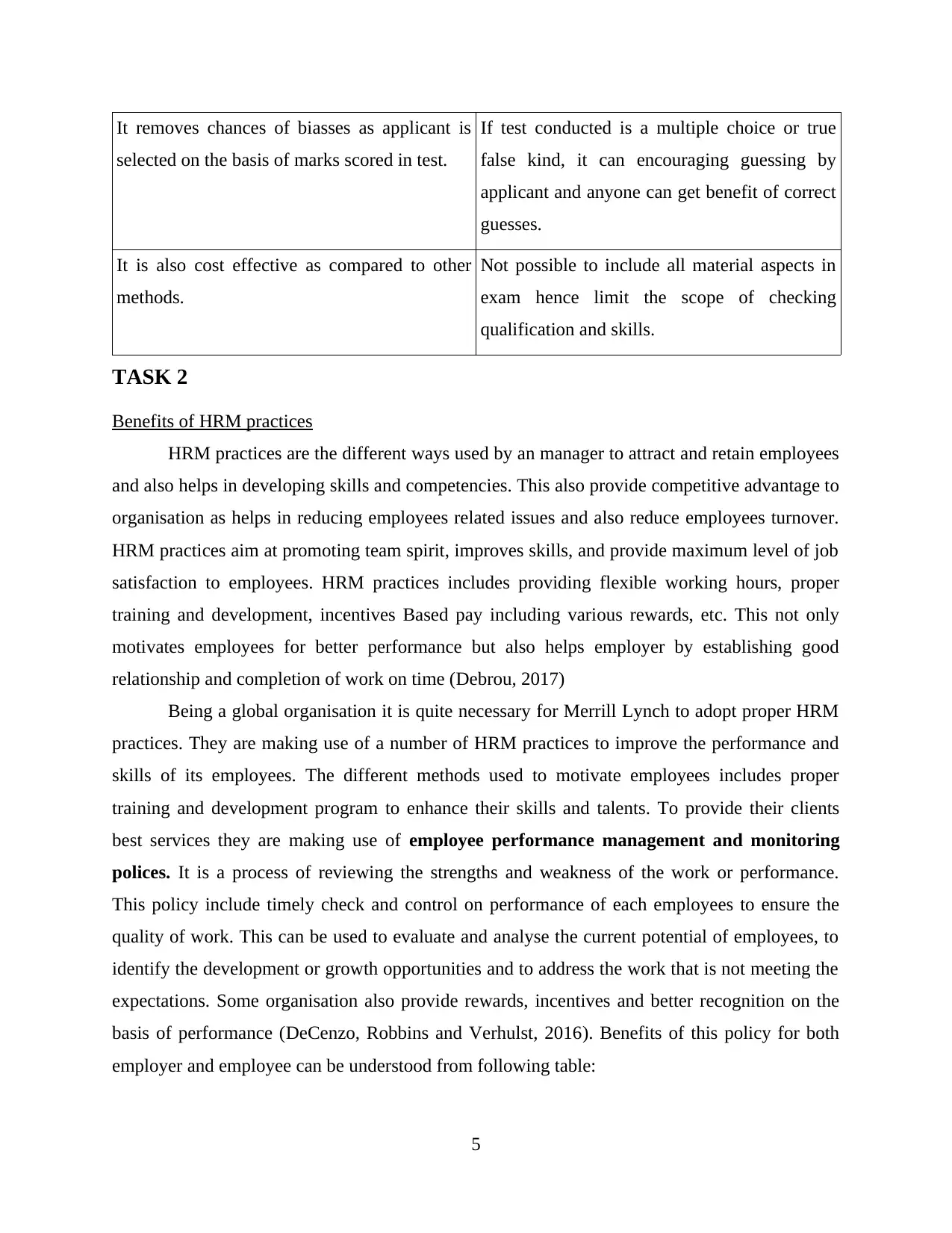
It removes chances of biasses as applicant is
selected on the basis of marks scored in test.
If test conducted is a multiple choice or true
false kind, it can encouraging guessing by
applicant and anyone can get benefit of correct
guesses.
It is also cost effective as compared to other
methods.
Not possible to include all material aspects in
exam hence limit the scope of checking
qualification and skills.
TASK 2
Benefits of HRM practices
HRM practices are the different ways used by an manager to attract and retain employees
and also helps in developing skills and competencies. This also provide competitive advantage to
organisation as helps in reducing employees related issues and also reduce employees turnover.
HRM practices aim at promoting team spirit, improves skills, and provide maximum level of job
satisfaction to employees. HRM practices includes providing flexible working hours, proper
training and development, incentives Based pay including various rewards, etc. This not only
motivates employees for better performance but also helps employer by establishing good
relationship and completion of work on time (Debrou, 2017)
Being a global organisation it is quite necessary for Merrill Lynch to adopt proper HRM
practices. They are making use of a number of HRM practices to improve the performance and
skills of its employees. The different methods used to motivate employees includes proper
training and development program to enhance their skills and talents. To provide their clients
best services they are making use of employee performance management and monitoring
polices. It is a process of reviewing the strengths and weakness of the work or performance.
This policy include timely check and control on performance of each employees to ensure the
quality of work. This can be used to evaluate and analyse the current potential of employees, to
identify the development or growth opportunities and to address the work that is not meeting the
expectations. Some organisation also provide rewards, incentives and better recognition on the
basis of performance (DeCenzo, Robbins and Verhulst, 2016). Benefits of this policy for both
employer and employee can be understood from following table:
5
selected on the basis of marks scored in test.
If test conducted is a multiple choice or true
false kind, it can encouraging guessing by
applicant and anyone can get benefit of correct
guesses.
It is also cost effective as compared to other
methods.
Not possible to include all material aspects in
exam hence limit the scope of checking
qualification and skills.
TASK 2
Benefits of HRM practices
HRM practices are the different ways used by an manager to attract and retain employees
and also helps in developing skills and competencies. This also provide competitive advantage to
organisation as helps in reducing employees related issues and also reduce employees turnover.
HRM practices aim at promoting team spirit, improves skills, and provide maximum level of job
satisfaction to employees. HRM practices includes providing flexible working hours, proper
training and development, incentives Based pay including various rewards, etc. This not only
motivates employees for better performance but also helps employer by establishing good
relationship and completion of work on time (Debrou, 2017)
Being a global organisation it is quite necessary for Merrill Lynch to adopt proper HRM
practices. They are making use of a number of HRM practices to improve the performance and
skills of its employees. The different methods used to motivate employees includes proper
training and development program to enhance their skills and talents. To provide their clients
best services they are making use of employee performance management and monitoring
polices. It is a process of reviewing the strengths and weakness of the work or performance.
This policy include timely check and control on performance of each employees to ensure the
quality of work. This can be used to evaluate and analyse the current potential of employees, to
identify the development or growth opportunities and to address the work that is not meeting the
expectations. Some organisation also provide rewards, incentives and better recognition on the
basis of performance (DeCenzo, Robbins and Verhulst, 2016). Benefits of this policy for both
employer and employee can be understood from following table:
5
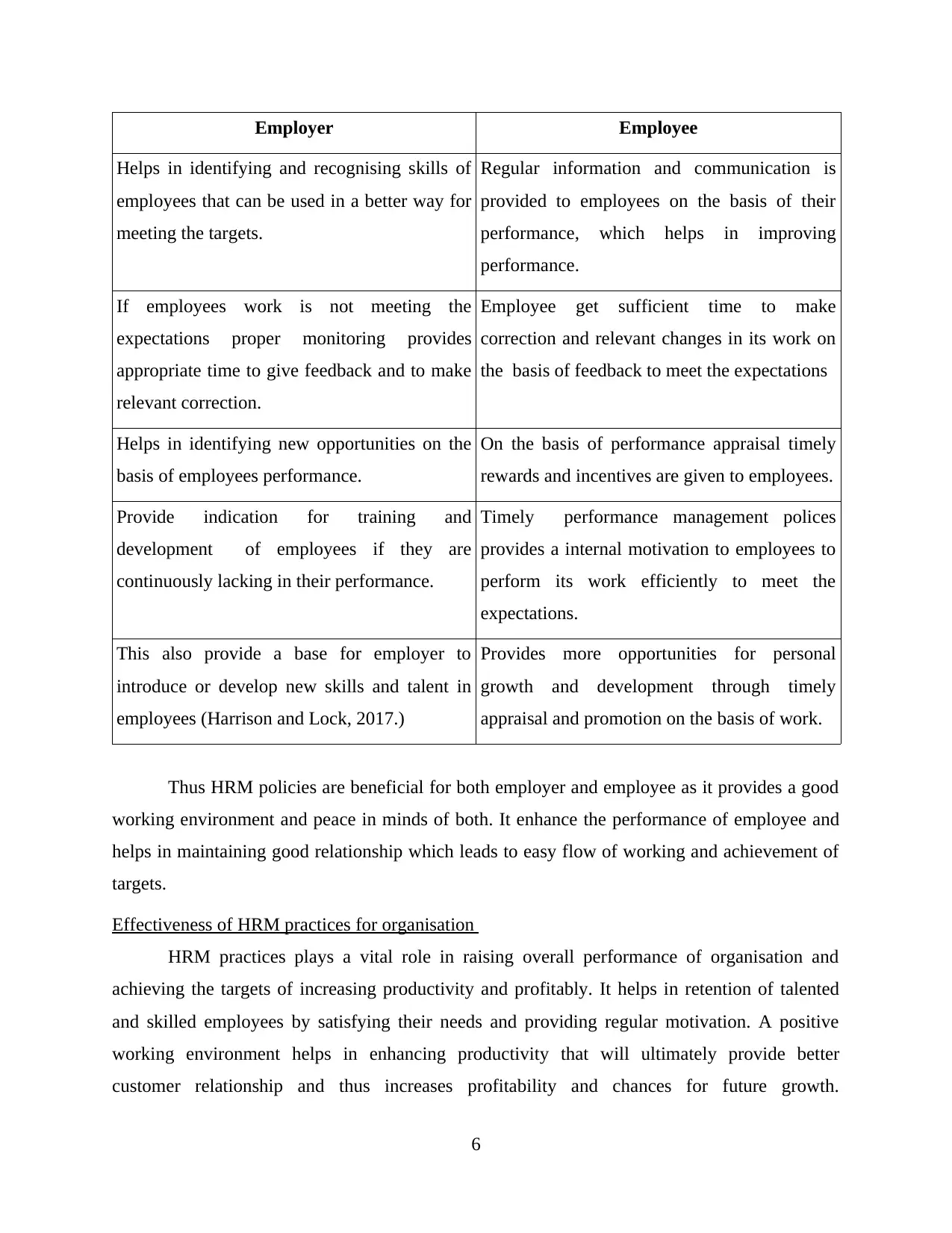
Employer Employee
Helps in identifying and recognising skills of
employees that can be used in a better way for
meeting the targets.
Regular information and communication is
provided to employees on the basis of their
performance, which helps in improving
performance.
If employees work is not meeting the
expectations proper monitoring provides
appropriate time to give feedback and to make
relevant correction.
Employee get sufficient time to make
correction and relevant changes in its work on
the basis of feedback to meet the expectations
Helps in identifying new opportunities on the
basis of employees performance.
On the basis of performance appraisal timely
rewards and incentives are given to employees.
Provide indication for training and
development of employees if they are
continuously lacking in their performance.
Timely performance management polices
provides a internal motivation to employees to
perform its work efficiently to meet the
expectations.
This also provide a base for employer to
introduce or develop new skills and talent in
employees (Harrison and Lock, 2017.)
Provides more opportunities for personal
growth and development through timely
appraisal and promotion on the basis of work.
Thus HRM policies are beneficial for both employer and employee as it provides a good
working environment and peace in minds of both. It enhance the performance of employee and
helps in maintaining good relationship which leads to easy flow of working and achievement of
targets.
Effectiveness of HRM practices for organisation
HRM practices plays a vital role in raising overall performance of organisation and
achieving the targets of increasing productivity and profitably. It helps in retention of talented
and skilled employees by satisfying their needs and providing regular motivation. A positive
working environment helps in enhancing productivity that will ultimately provide better
customer relationship and thus increases profitability and chances for future growth.
6
Helps in identifying and recognising skills of
employees that can be used in a better way for
meeting the targets.
Regular information and communication is
provided to employees on the basis of their
performance, which helps in improving
performance.
If employees work is not meeting the
expectations proper monitoring provides
appropriate time to give feedback and to make
relevant correction.
Employee get sufficient time to make
correction and relevant changes in its work on
the basis of feedback to meet the expectations
Helps in identifying new opportunities on the
basis of employees performance.
On the basis of performance appraisal timely
rewards and incentives are given to employees.
Provide indication for training and
development of employees if they are
continuously lacking in their performance.
Timely performance management polices
provides a internal motivation to employees to
perform its work efficiently to meet the
expectations.
This also provide a base for employer to
introduce or develop new skills and talent in
employees (Harrison and Lock, 2017.)
Provides more opportunities for personal
growth and development through timely
appraisal and promotion on the basis of work.
Thus HRM policies are beneficial for both employer and employee as it provides a good
working environment and peace in minds of both. It enhance the performance of employee and
helps in maintaining good relationship which leads to easy flow of working and achievement of
targets.
Effectiveness of HRM practices for organisation
HRM practices plays a vital role in raising overall performance of organisation and
achieving the targets of increasing productivity and profitably. It helps in retention of talented
and skilled employees by satisfying their needs and providing regular motivation. A positive
working environment helps in enhancing productivity that will ultimately provide better
customer relationship and thus increases profitability and chances for future growth.
6
⊘ This is a preview!⊘
Do you want full access?
Subscribe today to unlock all pages.

Trusted by 1+ million students worldwide
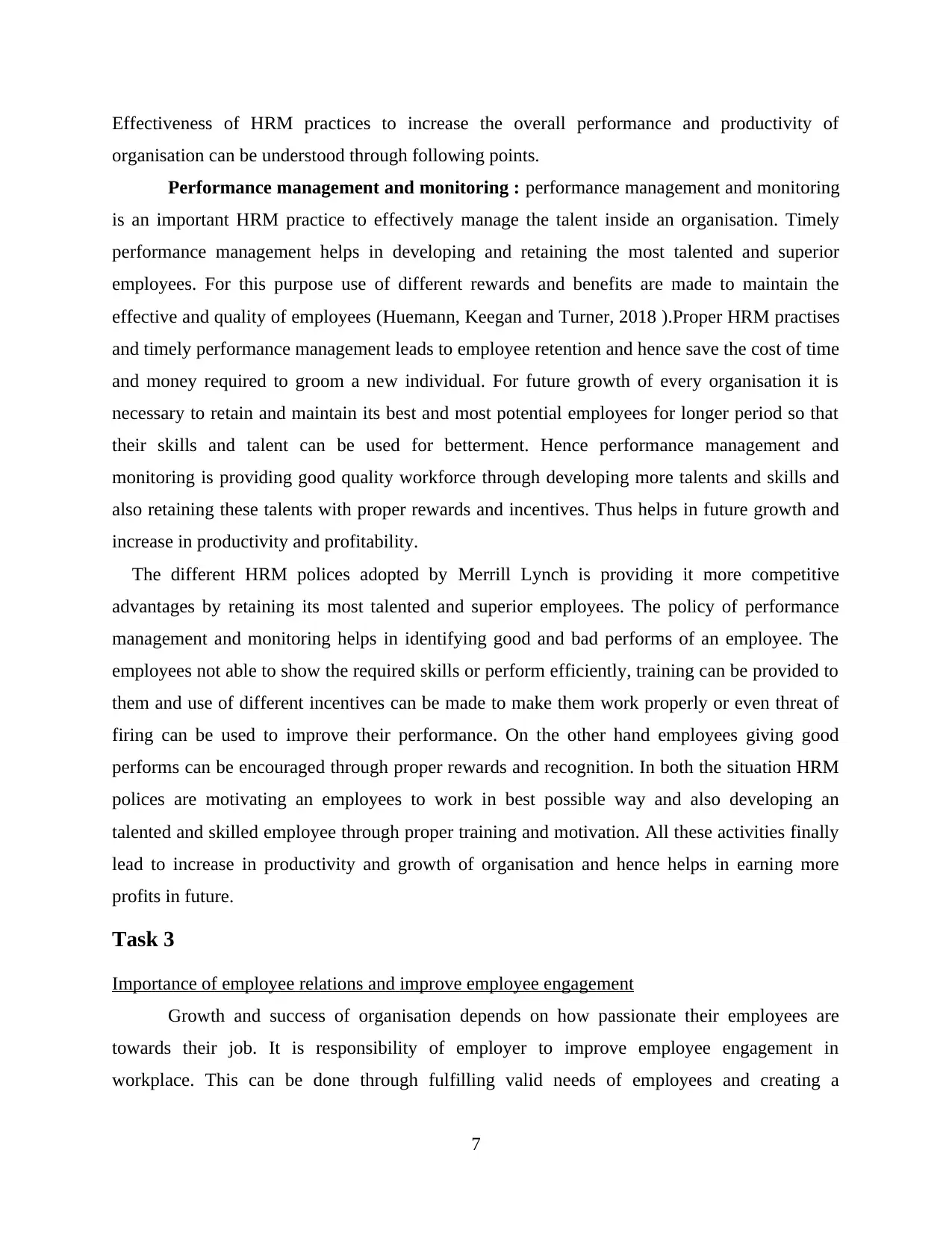
Effectiveness of HRM practices to increase the overall performance and productivity of
organisation can be understood through following points.
Performance management and monitoring : performance management and monitoring
is an important HRM practice to effectively manage the talent inside an organisation. Timely
performance management helps in developing and retaining the most talented and superior
employees. For this purpose use of different rewards and benefits are made to maintain the
effective and quality of employees (Huemann, Keegan and Turner, 2018 ).Proper HRM practises
and timely performance management leads to employee retention and hence save the cost of time
and money required to groom a new individual. For future growth of every organisation it is
necessary to retain and maintain its best and most potential employees for longer period so that
their skills and talent can be used for betterment. Hence performance management and
monitoring is providing good quality workforce through developing more talents and skills and
also retaining these talents with proper rewards and incentives. Thus helps in future growth and
increase in productivity and profitability.
The different HRM polices adopted by Merrill Lynch is providing it more competitive
advantages by retaining its most talented and superior employees. The policy of performance
management and monitoring helps in identifying good and bad performs of an employee. The
employees not able to show the required skills or perform efficiently, training can be provided to
them and use of different incentives can be made to make them work properly or even threat of
firing can be used to improve their performance. On the other hand employees giving good
performs can be encouraged through proper rewards and recognition. In both the situation HRM
polices are motivating an employees to work in best possible way and also developing an
talented and skilled employee through proper training and motivation. All these activities finally
lead to increase in productivity and growth of organisation and hence helps in earning more
profits in future.
Task 3
Importance of employee relations and improve employee engagement
Growth and success of organisation depends on how passionate their employees are
towards their job. It is responsibility of employer to improve employee engagement in
workplace. This can be done through fulfilling valid needs of employees and creating a
7
organisation can be understood through following points.
Performance management and monitoring : performance management and monitoring
is an important HRM practice to effectively manage the talent inside an organisation. Timely
performance management helps in developing and retaining the most talented and superior
employees. For this purpose use of different rewards and benefits are made to maintain the
effective and quality of employees (Huemann, Keegan and Turner, 2018 ).Proper HRM practises
and timely performance management leads to employee retention and hence save the cost of time
and money required to groom a new individual. For future growth of every organisation it is
necessary to retain and maintain its best and most potential employees for longer period so that
their skills and talent can be used for betterment. Hence performance management and
monitoring is providing good quality workforce through developing more talents and skills and
also retaining these talents with proper rewards and incentives. Thus helps in future growth and
increase in productivity and profitability.
The different HRM polices adopted by Merrill Lynch is providing it more competitive
advantages by retaining its most talented and superior employees. The policy of performance
management and monitoring helps in identifying good and bad performs of an employee. The
employees not able to show the required skills or perform efficiently, training can be provided to
them and use of different incentives can be made to make them work properly or even threat of
firing can be used to improve their performance. On the other hand employees giving good
performs can be encouraged through proper rewards and recognition. In both the situation HRM
polices are motivating an employees to work in best possible way and also developing an
talented and skilled employee through proper training and motivation. All these activities finally
lead to increase in productivity and growth of organisation and hence helps in earning more
profits in future.
Task 3
Importance of employee relations and improve employee engagement
Growth and success of organisation depends on how passionate their employees are
towards their job. It is responsibility of employer to improve employee engagement in
workplace. This can be done through fulfilling valid needs of employees and creating a
7
Paraphrase This Document
Need a fresh take? Get an instant paraphrase of this document with our AI Paraphraser
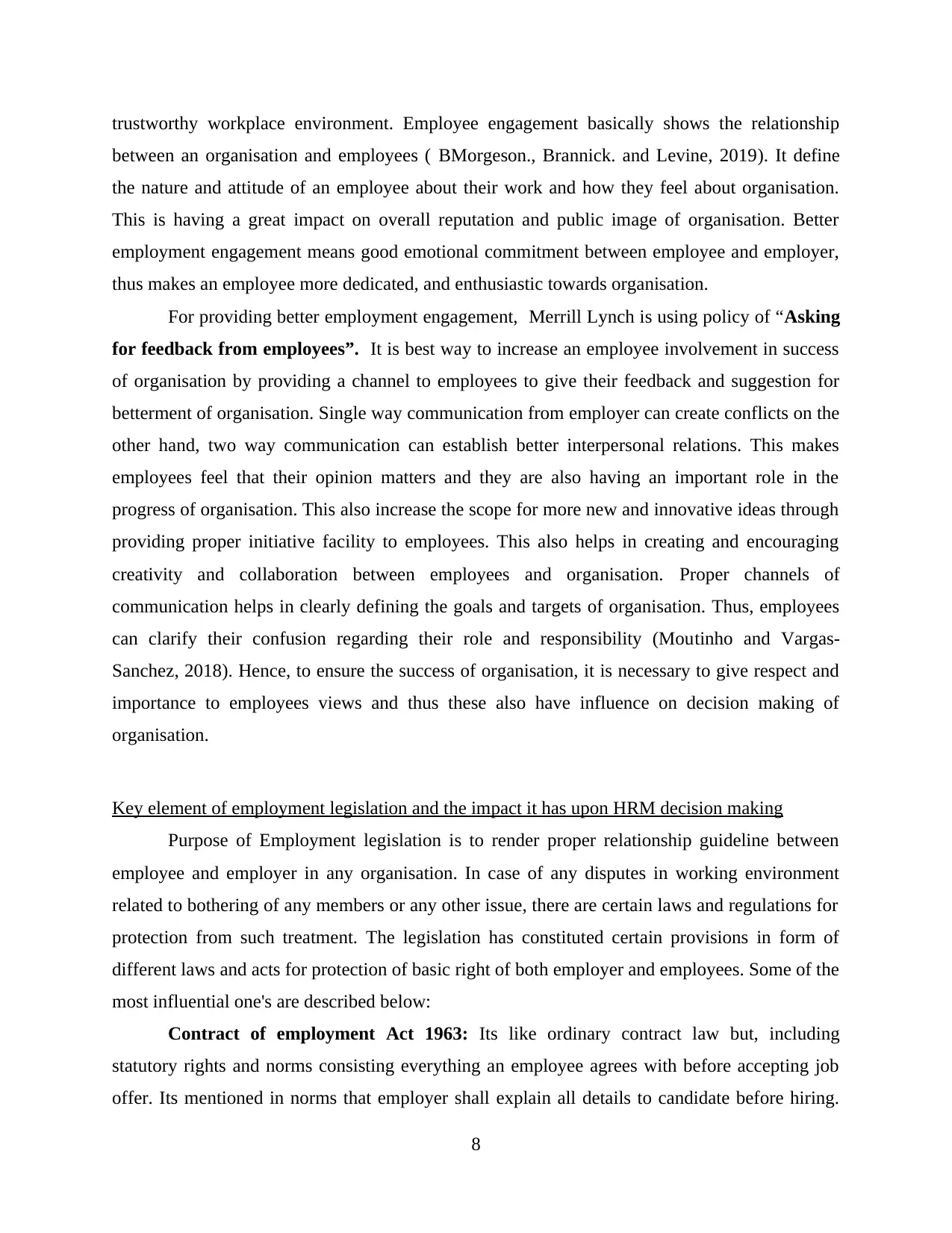
trustworthy workplace environment. Employee engagement basically shows the relationship
between an organisation and employees ( BMorgeson., Brannick. and Levine, 2019). It define
the nature and attitude of an employee about their work and how they feel about organisation.
This is having a great impact on overall reputation and public image of organisation. Better
employment engagement means good emotional commitment between employee and employer,
thus makes an employee more dedicated, and enthusiastic towards organisation.
For providing better employment engagement, Merrill Lynch is using policy of “Asking
for feedback from employees”. It is best way to increase an employee involvement in success
of organisation by providing a channel to employees to give their feedback and suggestion for
betterment of organisation. Single way communication from employer can create conflicts on the
other hand, two way communication can establish better interpersonal relations. This makes
employees feel that their opinion matters and they are also having an important role in the
progress of organisation. This also increase the scope for more new and innovative ideas through
providing proper initiative facility to employees. This also helps in creating and encouraging
creativity and collaboration between employees and organisation. Proper channels of
communication helps in clearly defining the goals and targets of organisation. Thus, employees
can clarify their confusion regarding their role and responsibility (Moutinho and Vargas-
Sanchez, 2018). Hence, to ensure the success of organisation, it is necessary to give respect and
importance to employees views and thus these also have influence on decision making of
organisation.
Key element of employment legislation and the impact it has upon HRM decision making
Purpose of Employment legislation is to render proper relationship guideline between
employee and employer in any organisation. In case of any disputes in working environment
related to bothering of any members or any other issue, there are certain laws and regulations for
protection from such treatment. The legislation has constituted certain provisions in form of
different laws and acts for protection of basic right of both employer and employees. Some of the
most influential one's are described below:
Contract of employment Act 1963: Its like ordinary contract law but, including
statutory rights and norms consisting everything an employee agrees with before accepting job
offer. Its mentioned in norms that employer shall explain all details to candidate before hiring.
8
between an organisation and employees ( BMorgeson., Brannick. and Levine, 2019). It define
the nature and attitude of an employee about their work and how they feel about organisation.
This is having a great impact on overall reputation and public image of organisation. Better
employment engagement means good emotional commitment between employee and employer,
thus makes an employee more dedicated, and enthusiastic towards organisation.
For providing better employment engagement, Merrill Lynch is using policy of “Asking
for feedback from employees”. It is best way to increase an employee involvement in success
of organisation by providing a channel to employees to give their feedback and suggestion for
betterment of organisation. Single way communication from employer can create conflicts on the
other hand, two way communication can establish better interpersonal relations. This makes
employees feel that their opinion matters and they are also having an important role in the
progress of organisation. This also increase the scope for more new and innovative ideas through
providing proper initiative facility to employees. This also helps in creating and encouraging
creativity and collaboration between employees and organisation. Proper channels of
communication helps in clearly defining the goals and targets of organisation. Thus, employees
can clarify their confusion regarding their role and responsibility (Moutinho and Vargas-
Sanchez, 2018). Hence, to ensure the success of organisation, it is necessary to give respect and
importance to employees views and thus these also have influence on decision making of
organisation.
Key element of employment legislation and the impact it has upon HRM decision making
Purpose of Employment legislation is to render proper relationship guideline between
employee and employer in any organisation. In case of any disputes in working environment
related to bothering of any members or any other issue, there are certain laws and regulations for
protection from such treatment. The legislation has constituted certain provisions in form of
different laws and acts for protection of basic right of both employer and employees. Some of the
most influential one's are described below:
Contract of employment Act 1963: Its like ordinary contract law but, including
statutory rights and norms consisting everything an employee agrees with before accepting job
offer. Its mentioned in norms that employer shall explain all details to candidate before hiring.
8
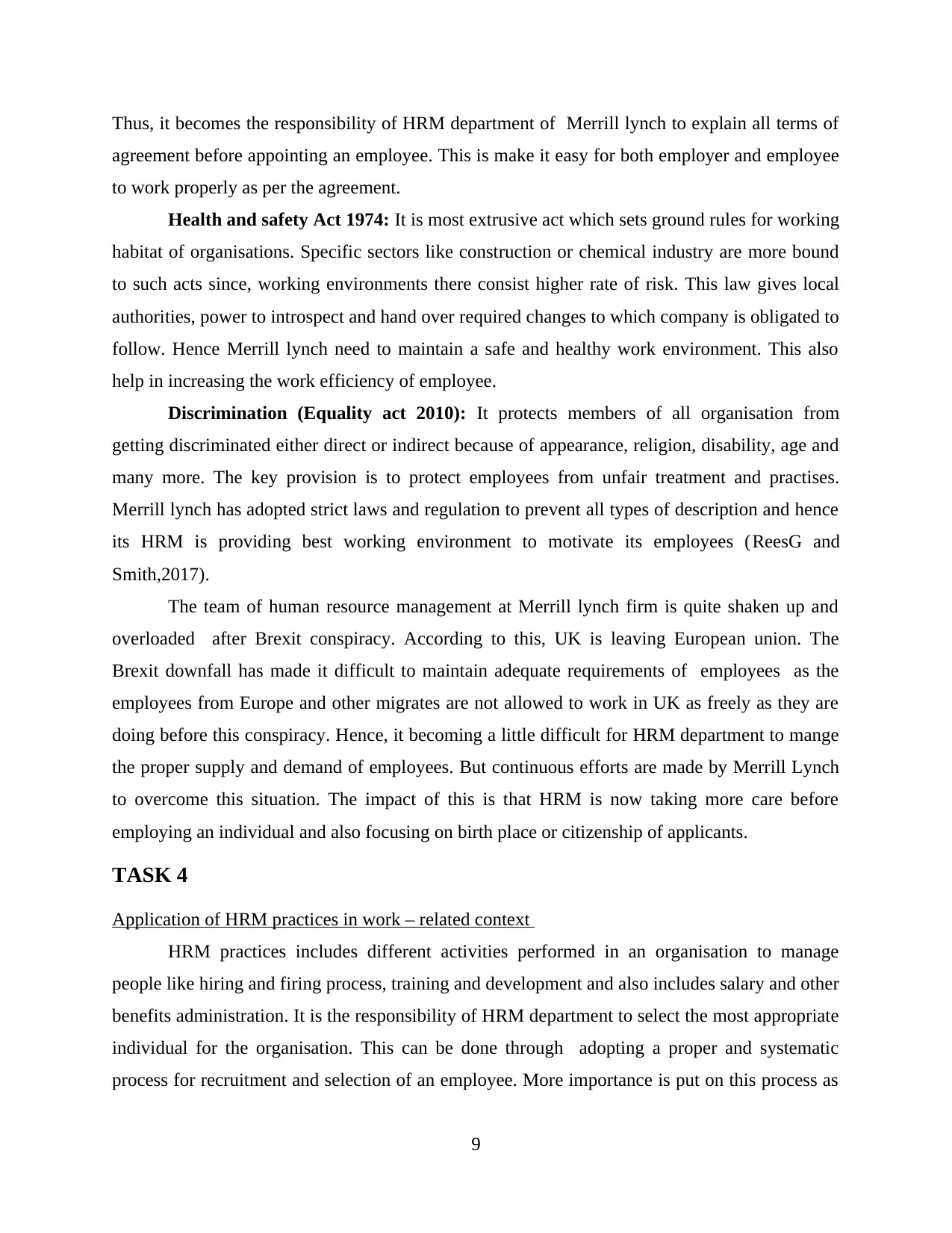
Thus, it becomes the responsibility of HRM department of Merrill lynch to explain all terms of
agreement before appointing an employee. This is make it easy for both employer and employee
to work properly as per the agreement.
Health and safety Act 1974: It is most extrusive act which sets ground rules for working
habitat of organisations. Specific sectors like construction or chemical industry are more bound
to such acts since, working environments there consist higher rate of risk. This law gives local
authorities, power to introspect and hand over required changes to which company is obligated to
follow. Hence Merrill lynch need to maintain a safe and healthy work environment. This also
help in increasing the work efficiency of employee.
Discrimination (Equality act 2010): It protects members of all organisation from
getting discriminated either direct or indirect because of appearance, religion, disability, age and
many more. The key provision is to protect employees from unfair treatment and practises.
Merrill lynch has adopted strict laws and regulation to prevent all types of description and hence
its HRM is providing best working environment to motivate its employees (ReesG and
Smith,2017).
The team of human resource management at Merrill lynch firm is quite shaken up and
overloaded after Brexit conspiracy. According to this, UK is leaving European union. The
Brexit downfall has made it difficult to maintain adequate requirements of employees as the
employees from Europe and other migrates are not allowed to work in UK as freely as they are
doing before this conspiracy. Hence, it becoming a little difficult for HRM department to mange
the proper supply and demand of employees. But continuous efforts are made by Merrill Lynch
to overcome this situation. The impact of this is that HRM is now taking more care before
employing an individual and also focusing on birth place or citizenship of applicants.
TASK 4
Application of HRM practices in work – related context
HRM practices includes different activities performed in an organisation to manage
people like hiring and firing process, training and development and also includes salary and other
benefits administration. It is the responsibility of HRM department to select the most appropriate
individual for the organisation. This can be done through adopting a proper and systematic
process for recruitment and selection of an employee. More importance is put on this process as
9
agreement before appointing an employee. This is make it easy for both employer and employee
to work properly as per the agreement.
Health and safety Act 1974: It is most extrusive act which sets ground rules for working
habitat of organisations. Specific sectors like construction or chemical industry are more bound
to such acts since, working environments there consist higher rate of risk. This law gives local
authorities, power to introspect and hand over required changes to which company is obligated to
follow. Hence Merrill lynch need to maintain a safe and healthy work environment. This also
help in increasing the work efficiency of employee.
Discrimination (Equality act 2010): It protects members of all organisation from
getting discriminated either direct or indirect because of appearance, religion, disability, age and
many more. The key provision is to protect employees from unfair treatment and practises.
Merrill lynch has adopted strict laws and regulation to prevent all types of description and hence
its HRM is providing best working environment to motivate its employees (ReesG and
Smith,2017).
The team of human resource management at Merrill lynch firm is quite shaken up and
overloaded after Brexit conspiracy. According to this, UK is leaving European union. The
Brexit downfall has made it difficult to maintain adequate requirements of employees as the
employees from Europe and other migrates are not allowed to work in UK as freely as they are
doing before this conspiracy. Hence, it becoming a little difficult for HRM department to mange
the proper supply and demand of employees. But continuous efforts are made by Merrill Lynch
to overcome this situation. The impact of this is that HRM is now taking more care before
employing an individual and also focusing on birth place or citizenship of applicants.
TASK 4
Application of HRM practices in work – related context
HRM practices includes different activities performed in an organisation to manage
people like hiring and firing process, training and development and also includes salary and other
benefits administration. It is the responsibility of HRM department to select the most appropriate
individual for the organisation. This can be done through adopting a proper and systematic
process for recruitment and selection of an employee. More importance is put on this process as
9
⊘ This is a preview!⊘
Do you want full access?
Subscribe today to unlock all pages.

Trusted by 1+ million students worldwide
1 out of 15
Related Documents
Your All-in-One AI-Powered Toolkit for Academic Success.
+13062052269
info@desklib.com
Available 24*7 on WhatsApp / Email
![[object Object]](/_next/static/media/star-bottom.7253800d.svg)
Unlock your academic potential
Copyright © 2020–2025 A2Z Services. All Rights Reserved. Developed and managed by ZUCOL.





